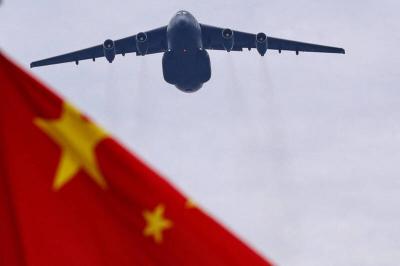The National Communications Commission (NCC) yesterday ordered Taiwan Mobile to recall all of its self-branded, China-made smartphones after the phones’ built-in software was found to contain a malicious program exploitable by scammers.
The telecom in April 2018 launched the Amazing A32 smartphone, which was manufactured in China, to encourage 3G users to upgrade to 4G, the commission said.
The phone cost NT$1,990 (US$70 at the current exchange rate).

Photo courtesy of the National Communications Commission
The telecom sold about 90,000 units of the model before it stopped offering them in July last year, NCC data showed.
As of Dec. 20, about 7,600 Taiwan Mobile subscribers were still using the smartphone, while the remainder of the buyers had migrated to other carriers or bought new smartphones, the commission said.
The Criminal Investigation Bureau last year informed the ministry of the information security breach, NCC Deputy Chairman Wong Po-tsung (翁柏宗) said, adding that the commission had also received five complaints from service subscribers.
The bureau’s investigation found that the implanted program enabled scammers to obtain subscribers’ phone numbers, which they then used to open accounts for mobile game apps.
The apps would send the Taiwan Mobile subscribers a text message with a verification code, which the malicious program would also send to the scammers.
After the scammers finished registering on the mobile game apps, the text message would be automatically deleted from the subscribers’ phones. All of this would proceed without the subscribers’ knowledge.
The company should recall the smartphones “as soon as possible,” Wong said, without specifying a time frame.
The recall would allow subscribers to request a software update or a partial refund, Wong added.
Taiwan Mobile has set up a customer service hotline (0809-000-852) to answer questions from all Amazing A32 users, including those who have switched to other carriers.
Failure to address the problem could constitute a breach of the Telecommunications Management Act (電信管理法) and the telecom could face a fine of up to NT$1 million, Wong said, adding that the company could be fined until the issue is resolved.
To protect people from information security breaches on mobile phones manufactured in China, telecoms can only sell self-branded mobile phones manufactured in China after they obtain information security certification from the Taiwan Association of Information and Communication Standards, he said.
The telecoms must sign an affidavit saying that they would enforce remedial measures to address security breaches caused by preinstalled software on the phones, he added.
The commission would randomly check the top 10 models in Taiwan and mobile phones made in China to ensure that they meet national information security standards, Wong said, adding that telecoms and manufacturers that fail annual inspections would be required to resolve the issues immediately.
The commission already required mobile phone manufacturers to sign an affidavit guaranteeing that phones would not show Taiwan as being part of China after software updates, the ministry said.
Contravening the regulation would keep the commission from certifying a smartphone’s specifications, which manufacturers need to sell products in Taiwan, it added.

Beijing could eventually see a full amphibious invasion of Taiwan as the only "prudent" way to bring about unification, the US Department of Defense said in a newly released annual report to Congress. The Pentagon's "Annual Report to Congress: Military and Security Developments Involving the People's Republic of China 2025," was in many ways similar to last year’s report but reorganized the analysis of the options China has to take over Taiwan. Generally, according to the report, Chinese leaders view the People's Liberation Army's (PLA) capabilities for a Taiwan campaign as improving, but they remain uncertain about its readiness to successfully seize

Taiwan is getting a day off on Christmas for the first time in 25 years. The change comes after opposition parties passed a law earlier this year to add or restore five public holidays, including Constitution Day, which falls on today, Dec. 25. The day marks the 1947 adoption of the constitution of the Republic of China, as the government in Taipei is formally known. Back then the Chinese Nationalist Party (KMT) governed China from Nanjing. When the KMT, now an opposition party in Taiwan, passed the legislation on holidays, it said that they would help “commemorate the history of national development.” That

Taiwan has overtaken South Korea this year in per capita income for the first time in 23 years, IMF data showed. Per capita income is a nation’s GDP divided by the total population, used to compare average wealth levels across countries. Taiwan also beat Japan this year on per capita income, after surpassing it for the first time last year, US magazine Newsweek reported yesterday. Across Asia, Taiwan ranked fourth for per capita income at US$37,827 this year due to sustained economic growth, the report said. In the top three spots were Singapore, Macau and Hong Kong, it said. South

Snow fell on Yushan (Jade Mountain, 玉山) yesterday morning as a continental cold air mass sent temperatures below freezing on Taiwan’s tallest peak, the Central Weather Administration (CWA) said. Snowflakes were seen on Yushan’s north peak from 6:28am to 6:38am, but they did not fully cover the ground and no accumulation was recorded, the CWA said. As of 7:42am, the lowest temperature recorded across Taiwan was minus-5.5°C at Yushan’s Fengkou observatory and minus-4.7°C at the Yushan observatory, CWA data showed. On Hehuanshan (合歡山) in Nantou County, a low of 1.3°C was recorded at 6:39pm, when ice pellets fell at Songsyue Lodge (松雪樓), a